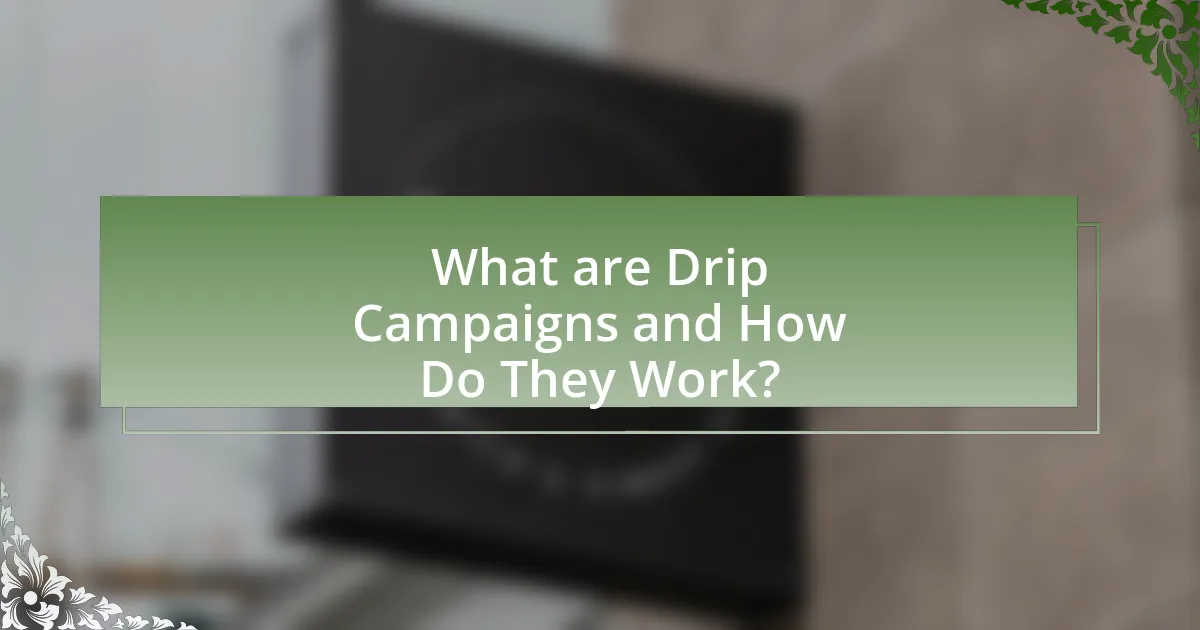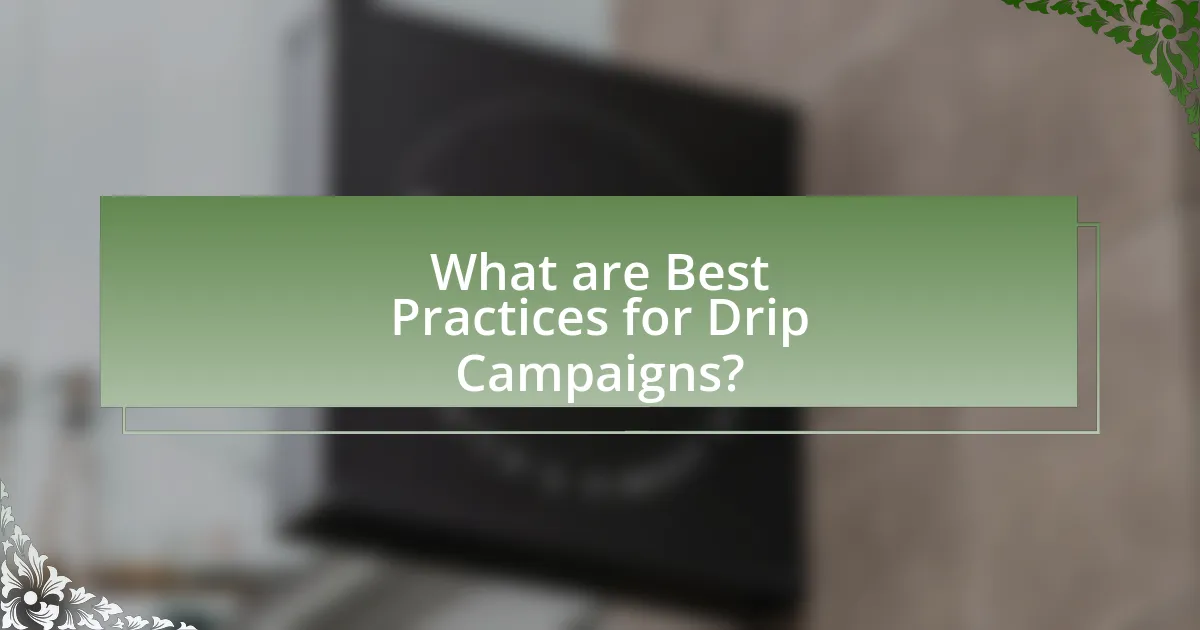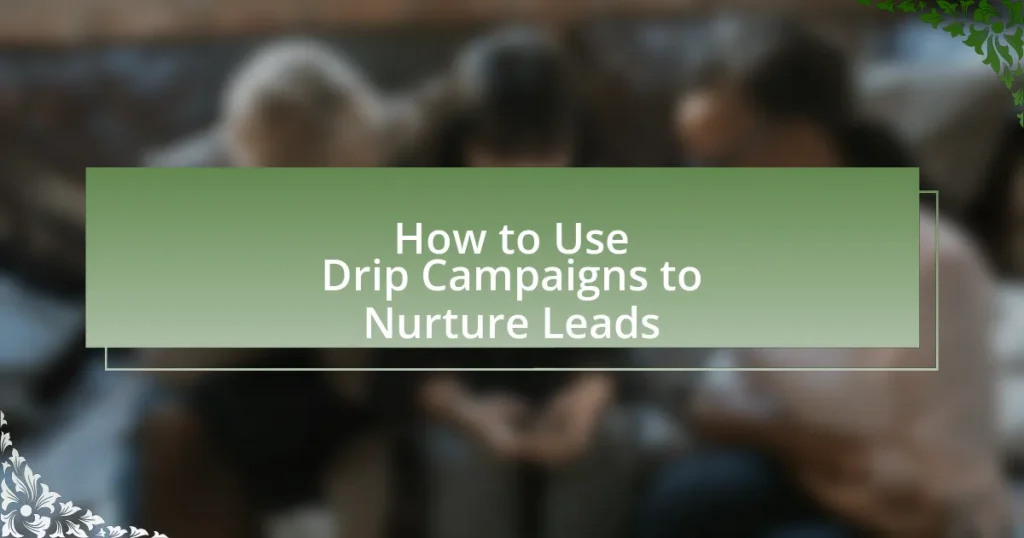Drip campaigns are automated marketing strategies designed to nurture leads through a series of targeted, pre-written messages delivered over time. This article outlines the key components of effective drip campaigns, including audience segmentation, personalized content, and automation, which collectively enhance customer engagement and conversion rates. It also discusses the importance of measuring campaign success through key performance indicators and offers best practices for implementation, such as maintaining subscriber interest and avoiding common pitfalls. By leveraging these strategies, businesses can significantly improve their lead nurturing efforts and drive higher sales opportunities.

What are Drip Campaigns and How Do They Work?
Drip campaigns are automated marketing strategies that deliver a series of pre-written messages to potential customers over time. These campaigns work by sending targeted content based on user behavior, preferences, or specific timelines, allowing businesses to nurture leads effectively. For instance, a study by HubSpot found that companies using drip campaigns can see a 20% increase in sales opportunities, demonstrating their effectiveness in engaging and converting leads.
How do drip campaigns differ from other marketing strategies?
Drip campaigns differ from other marketing strategies by delivering a series of automated, targeted messages over time to nurture leads based on their behavior and engagement. Unlike traditional marketing strategies that often rely on one-time promotions or broad messaging, drip campaigns focus on personalized communication that adapts to the recipient’s actions, such as email opens or website visits. This approach increases engagement rates; for instance, studies show that drip campaigns can lead to a 20% increase in sales opportunities compared to standard email blasts.
What are the key components of a successful drip campaign?
The key components of a successful drip campaign include targeted audience segmentation, personalized content, a well-defined schedule, and performance tracking. Targeted audience segmentation ensures that messages are tailored to specific groups, increasing relevance and engagement. Personalized content enhances the connection with recipients by addressing their unique needs and interests. A well-defined schedule maintains consistent communication, preventing overwhelming recipients while ensuring timely delivery of information. Performance tracking allows marketers to analyze engagement metrics, enabling continuous optimization of the campaign. These components collectively contribute to the effectiveness of drip campaigns in nurturing leads.
How does automation play a role in drip campaigns?
Automation is essential in drip campaigns as it enables the systematic scheduling and delivery of targeted messages to leads over time. This technology allows marketers to create predefined workflows that automatically send emails or notifications based on specific triggers, such as user behavior or time intervals. For instance, a study by HubSpot found that automated emails can generate 320% more revenue than non-automated emails, highlighting the effectiveness of automation in enhancing engagement and conversion rates in drip campaigns.
Why are drip campaigns important for lead nurturing?
Drip campaigns are important for lead nurturing because they facilitate consistent and targeted communication with potential customers over time. This approach allows businesses to deliver relevant content based on the lead’s behavior and interests, which increases engagement and builds trust. According to a study by the Direct Marketing Association, targeted emails can generate six times higher transaction rates compared to non-targeted emails, demonstrating the effectiveness of personalized communication in nurturing leads.
What specific benefits do drip campaigns provide for businesses?
Drip campaigns provide businesses with targeted communication, increased engagement, and improved conversion rates. By delivering automated, relevant content over time, businesses can nurture leads effectively, guiding them through the sales funnel. According to a study by the Direct Marketing Association, targeted emails can generate a 760% increase in revenue, demonstrating the financial impact of well-executed drip campaigns. Additionally, drip campaigns help maintain consistent contact with potential customers, fostering brand loyalty and enhancing customer relationships.
How do drip campaigns enhance customer engagement?
Drip campaigns enhance customer engagement by delivering targeted, automated messages over time, which keeps customers informed and nurtured throughout their buyer journey. This consistent communication fosters a relationship between the brand and the customer, increasing the likelihood of conversions. According to a study by the Direct Marketing Association, targeted emails can generate six times more revenue than non-targeted emails, demonstrating the effectiveness of personalized messaging in engaging customers.

How to Create an Effective Drip Campaign?
To create an effective drip campaign, first define your target audience and segment them based on their behaviors and preferences. This segmentation allows for personalized messaging that resonates with each group. Next, develop a series of automated emails that provide valuable content, such as educational resources or product updates, delivered at strategic intervals to maintain engagement.
Research indicates that personalized emails can improve click-through rates by 14% and conversion rates by 10% (Experian). Additionally, monitor the performance of your campaign through metrics like open rates, click rates, and conversions to optimize future messages. By continuously refining your approach based on data, you can enhance the effectiveness of your drip campaign.
What steps should be taken to design a drip campaign?
To design a drip campaign, first define the target audience and their specific needs. Next, create a series of automated emails that provide valuable content tailored to those needs, ensuring each email builds on the previous one. Then, establish a timeline for sending these emails, typically spaced out over days or weeks to maintain engagement without overwhelming the recipient. Finally, monitor the campaign’s performance through metrics such as open rates and click-through rates, allowing for adjustments based on recipient behavior. This structured approach is supported by research indicating that targeted email campaigns can increase engagement by up to 50%.
How do you define your target audience for a drip campaign?
To define your target audience for a drip campaign, analyze demographic, psychographic, and behavioral data of potential customers. This involves segmenting your audience based on factors such as age, gender, interests, purchasing behavior, and engagement levels. For instance, a study by HubSpot indicates that personalized email campaigns can achieve a 29% higher open rate and a 41% higher click-through rate, demonstrating the effectiveness of targeting specific audience segments. By understanding these characteristics, marketers can tailor their messaging and content to resonate with the audience, ultimately enhancing engagement and conversion rates.
What types of content should be included in a drip campaign?
A drip campaign should include a variety of content types such as educational resources, promotional offers, customer testimonials, and personalized messages. Educational resources, like how-to guides or industry insights, help nurture leads by providing valuable information that addresses their needs. Promotional offers can incentivize conversions by presenting time-sensitive discounts or exclusive deals. Customer testimonials build trust and credibility, showcasing real-life success stories that resonate with potential customers. Personalized messages enhance engagement by addressing the recipient by name and tailoring content to their specific interests or behaviors. This diverse content strategy effectively nurtures leads through different stages of the buyer’s journey.
How can you measure the success of your drip campaign?
To measure the success of your drip campaign, analyze key performance indicators (KPIs) such as open rates, click-through rates, conversion rates, and unsubscribe rates. Open rates indicate how many recipients engaged with your emails, while click-through rates show the percentage of users who clicked on links within those emails. Conversion rates reflect the number of recipients who completed a desired action, such as making a purchase or signing up for a webinar, after interacting with the campaign. Unsubscribe rates help assess whether the content resonates with the audience. According to a 2021 report by Mailchimp, the average open rate for drip campaigns is around 21.33%, and the average click-through rate is approximately 2.62%, providing benchmarks for evaluating your campaign’s effectiveness.
What key performance indicators (KPIs) should you track?
You should track open rates, click-through rates, conversion rates, and unsubscribe rates as key performance indicators (KPIs) for drip campaigns. Open rates indicate the percentage of recipients who opened your emails, reflecting the effectiveness of your subject lines and timing. Click-through rates measure the percentage of recipients who clicked on links within your emails, showcasing engagement levels. Conversion rates track the percentage of recipients who completed a desired action, such as making a purchase or signing up for a webinar, demonstrating the campaign’s overall effectiveness. Unsubscribe rates reveal the percentage of recipients who opted out of your emails, providing insight into content relevance and audience satisfaction. Monitoring these KPIs allows for data-driven adjustments to improve campaign performance and lead nurturing strategies.
How can A/B testing improve your drip campaign results?
A/B testing can significantly improve your drip campaign results by allowing marketers to compare different versions of emails to determine which performs better in terms of open rates, click-through rates, and conversions. By systematically testing variables such as subject lines, content, and call-to-action buttons, marketers can identify the most effective elements that resonate with their audience. For instance, a study by Optimizely found that A/B testing can lead to conversion rate increases of up to 49%. This data-driven approach enables continuous optimization of campaigns, ensuring that each iteration is more effective than the last.

What are Best Practices for Drip Campaigns?
Best practices for drip campaigns include segmenting your audience, personalizing content, timing your messages appropriately, and analyzing performance metrics. Segmenting your audience allows for targeted messaging, which can increase engagement rates; for instance, a study by HubSpot found that segmented campaigns can lead to a 760% increase in revenue. Personalizing content enhances relevance, as personalized emails have been shown to improve click-through rates by 14% and conversion rates by 10%, according to Experian. Timing is crucial; sending emails at optimal times can significantly boost open rates, with research indicating that emails sent on Tuesdays have the highest open rates. Finally, regularly analyzing performance metrics helps refine strategies, ensuring continuous improvement and effectiveness of the campaigns.
How can personalization enhance your drip campaigns?
Personalization enhances drip campaigns by increasing engagement and conversion rates. When messages are tailored to individual preferences and behaviors, recipients are more likely to interact with the content. For instance, studies show that personalized emails can lead to a 26% increase in open rates and a 760% increase in revenue, according to a report by Experian. By utilizing data such as past purchases, browsing history, and demographic information, marketers can create targeted messages that resonate with each recipient, ultimately leading to higher retention and satisfaction.
What tools can help automate and optimize your drip campaigns?
Tools that can help automate and optimize your drip campaigns include HubSpot, Mailchimp, and ActiveCampaign. HubSpot offers a comprehensive marketing automation platform that allows users to create targeted drip campaigns based on user behavior and engagement metrics. Mailchimp provides user-friendly automation features that enable segmentation and personalized messaging, enhancing campaign effectiveness. ActiveCampaign combines email marketing with CRM capabilities, allowing for advanced automation workflows that adapt to customer interactions. These tools are widely recognized for their ability to streamline the drip campaign process and improve lead nurturing outcomes.
How often should you send emails in a drip campaign?
In a drip campaign, emails should typically be sent every 3 to 7 days. This frequency allows for consistent engagement without overwhelming the recipient. Research indicates that sending emails too frequently can lead to higher unsubscribe rates, while spacing them out too much may result in decreased engagement. A study by HubSpot found that campaigns with a frequency of 1 to 2 emails per week had the highest open and click-through rates, reinforcing the effectiveness of this timing strategy.
What common mistakes should be avoided in drip campaigns?
Common mistakes to avoid in drip campaigns include sending irrelevant content, failing to segment the audience, and not monitoring engagement metrics. Sending irrelevant content can lead to high unsubscribe rates, as recipients may find the messages unhelpful or annoying. Failing to segment the audience results in a one-size-fits-all approach, which diminishes the effectiveness of the campaign; research shows that segmented campaigns can lead to a 760% increase in revenue. Not monitoring engagement metrics prevents marketers from understanding what resonates with their audience, hindering the ability to optimize future communications.
How can you ensure your emails do not end up in spam folders?
To ensure your emails do not end up in spam folders, maintain a clean email list and use double opt-in methods for subscriptions. A clean email list reduces bounce rates and increases engagement, which are critical factors for email deliverability. According to a study by Return Path, emails sent to engaged users have a 20% higher chance of landing in the inbox rather than the spam folder. Additionally, avoid using spam-trigger words in your subject lines and content, as these can flag your emails for spam filters. Implementing proper authentication protocols like SPF, DKIM, and DMARC also enhances your email’s credibility, further reducing the likelihood of being marked as spam.
What strategies can help maintain subscriber interest throughout the campaign?
To maintain subscriber interest throughout a drip campaign, personalized content is essential. Personalization increases engagement by 74%, as it makes subscribers feel valued and understood. Additionally, segmenting the audience based on behavior and preferences allows for tailored messaging that resonates more effectively with each group. Incorporating interactive elements, such as polls or quizzes, can also enhance engagement, as they encourage active participation. Furthermore, maintaining a consistent schedule for sending emails keeps subscribers anticipating future communications, which fosters ongoing interest. Lastly, analyzing engagement metrics enables marketers to adjust strategies in real-time, ensuring that content remains relevant and appealing.
What are some practical tips for implementing drip campaigns effectively?
To implement drip campaigns effectively, segment your audience based on their behavior and preferences. This allows for personalized messaging that resonates with each group, increasing engagement rates. Additionally, create a clear timeline for your emails, ensuring that each message builds on the previous one and guides the recipient through the customer journey. Use A/B testing to optimize subject lines and content, as studies show that tailored messages can improve open rates by up to 26%. Finally, monitor key metrics such as open rates, click-through rates, and conversions to refine your strategy continuously, ensuring that your campaigns remain effective over time.




